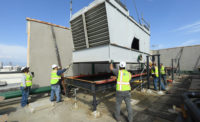Specialty contractors in the region are still finding plenty of work, although slowdowns have affected construction markets in Arkansas, Oklahoma, Louisiana, Mississippi and Texas over the past year.
Ninety-two firms posted more than $11 billion in combined revenue across the five states in 2016, according to this year’s ENR Texas & Louisiana Top Specialty Contractors ranking. In last year’s survey, combined regional revenue totaled $9 billion from 83 firms across Texas and Louisiana.
On Nov. 21, the Associated Builders and Contractors released data showing a drop in annual growth in real construction spending across the five-state region during 2016. Arkansas and Texas saw gains of 1.4% and 1.3%, respectively, down from 2015 totals of 2.7% and 5.1%.
Mississippi and Louisiana saw decreases of -2.5% and -0.6%, respectively, declines that were less severe than what the states posted in 2015, when they were -5.6% and -0.7%. Oklahoma was the only state in the region to go from increased spending in 2015 of 1.7% to a decline in spending of -1.2% in 2016.
ABC says that the drop in spending in Mississippi, which had the fifth-largest decrease of all states in real construction spending in 2016, was a result of the state’s underperforming energy sector, mainly in natural gas. However, that decline was offset by gains in areas such as manufacturing, retail and professional and business services, according to ABC.
Members of the American Subcontractors Association of Mississippi (ASA MS) report that the state’s subcontractors have experienced a slightly improving market, with fewer bidders and somewhat better margins compared with last year—although margins are still quite low, says Lloyd Spivey, ASA MS executive director.
Mississippi’s subcontractors also are seeing a rapid increase in pay for some skill sets as contractors pursue the same pool of tradespeople. While unskilled labor is readily available across the state, skilled labor shortages continue.
ENR Texas & Louisiana 2017 Top Specialty Contractors
The state is not investing heavily in projects because of recession anxiety, ASA MS members say, and that in turn limits construction markets, especially since many of Mississippi’s buildings and infrastructure need to be updated.
ASA MS members also report that payment issues remain a problem. Some state and city jobs are taking three to six months to pay their vendors and contractors. Meanwhile, out-of-state contractors are working in Mississippi but many leave without getting a state certificate or paying their subs.
To the north, Arkansas’ construction markets continue to grow. “We seem to be getting a lot of high school work in Little Rock,” says Bill Roachell, president of ABC of Arkansas. “Some of our schools in the Little Rock school district are old and, honestly, some of them need to be torn down.”
In October, project teams broke ground on the $90-million Southwest Little Rock High School project, which will house the combined population of two existing high schools, McClellan and J.A. Fair.
Northwest Arkansas has plenty of construction work as well, Roachell adds. “I hope that we can get some of the tax cuts through that the president is proposing. Hopefully, some of those will help stimulate a little more growth,” he says. “Our people continue to face a workforce shortage—trying to find good people, people that will actually come to work and be able to pass a drug test is huge.”
In Texas, Houston’s commercial market has slowed, but both San Antonio and Austin have improved, says Tom Ward, director of business development at Keystone Concrete. His firm posted $385 million in regional revenue in 2016, an increase of $20 million. Customer diversity helped Keystone grow, as did the opening of its new structural-concrete division in Austin.
Vertical office projects have slowed in Houston, Ward says, but “several of our customers are saying big projects are coming in 2018.”
Carrollton, Texas-based The Brandt Cos. LLC recorded $416 million in regional revenue in 2016, a gain of $16 million. The firm credits that increase to better traction in the Houston market after investing in its business strategy there over the last five years, says Steve Hayes, Brandt senior vice president.
“Labor resources have been in high demand and have forced us to evaluate opportunities more precisely to make sure we can continue to meet customer expectations,” Hayes adds. But construction activity for the firm “is brisk with no falloff projected for 2018,” he says.
Meanwhile, Houston’s commercial market is “pretty slow,” thanks to an abundance of empty office space in and around the city, says Ron LaRicci, vice president at Camarata Masonry Systems Ltd. and president of the ASA Houston Chapter. The commercial slowdown is affecting Camarata’s stone and tile divisions, but the masonry unit is busy on K-12 schools and college projects.
“I would think that other contractors that do not work on schools and campuses are having a difficult time right now,” LaRicci says. “Fortunately, we are diverse enough to sustain when one or two of the divisions are slow as long as one maintains some backlog.”
Hattie Peterson, senior vice president of marketing and communications at TDIndustries, says while “we are not seeing as many megaprojects on the horizon like we have seen in the past three years and the overall economy in the Southwest seems to be softening a bit, we are still in a strong market, particularly in Texas.”
TDIndustries posted $587 million in regional revenue for 2016, a gain of $91 million. The markets where TD has a focus, including commercial, entertainment, health care and data centers, continue to look favorable, and the firm expects the volume and pace of projects to continue its current momentum for the balance of 2017 and into 2018.
“I don’t think it’s anything new, but we’re definitely seeing the industry move toward a heavy design-assist, design-build environment,” Peterson says. “Projects aren’t necessarily being shelved, but sometimes construction is ahead of design and so we are doing a lot more of that design-assist, early involvement work.”
TD has 28 constructibility engineers on staff whose primary role is to help on design-assist jobs. These individuals are active on about 85-90% of the firm’s projects, Peterson says.
“Prefabrication has also been key to keeping projects on schedule. For all of our construction projects, we identify all of the products that we can fabricate in our manufacturing facility,” Peterson says. “We provide ductwork, piping and multi-trade fabrication, which has greatly reduced the installation time in the field while increasing safety for our partners.”
Multifamily work in Houston has surged in the aftermath of Hurricane Harvey, notes Tyler Althouse, vice president at Texas Moisture Protection Co. and the secretary/treasurer at ASA Houston.
“There wasn’t much demand before Harvey, and now there’s a much greater demand with all the houses that got destroyed,” Althouse says. “So that kind of saved the multifamily market.” Industrial work has also increased across Texas but hasn’t reached the levels of a few years ago, Althouse adds.
Hurricane Harvey repairs have contributed to the workforce shortage as well. Because the recovery will take some time, it may be difficult to entice those workers back from residential and renovation contractors, LaRicci says. “It depends upon the timing of the commercial market recovery. We will see,” he adds.
Management shortages continue to weigh on subcontractors across the region. “We’re having a hard time finding managers, but also I think the general contractor market is having just as hard a time,” Althouse notes. “That concerns me because the people that are in control of the jobs are maybe not as skilled or experienced as they should be.”
Meanwhile, the energy and industrial markets continue to generate work.
“We believe that Texas and Louisiana are very well positioned in the natural gas arena. Both states are located at the ends of major pipelines which enable gas processing as well as liquefaction and shipping to overseas ports, and both states are industry friendly and have the workforce and material supply readily available,” says Grady Saucier, senior vice president at MMR Group. “MMR does not see a major shift in what we have seen in the past two years.”
The firm posted $410 million in regional revenue in 2016, a gain of $93 million.
With the continuing shift of major industrial projects related to the low price of natural gas, MMR’s scope of services is now finding demand from local construction projects, Saucier says. “There were no major shifts in MMR’s business model, just the fact that there is more work in the Texas and Louisiana region than in other regions of the country,” he says.
Looking ahead to 2018, LaRicci sees the commercial market improving in the Houston area, and he expects plenty of work in Austin. “Dallas is doing well right now, but I have been told, and I believe it, that they are slowing down considerably and will be down in 2018,” he says.









Post a comment to this article
Report Abusive Comment